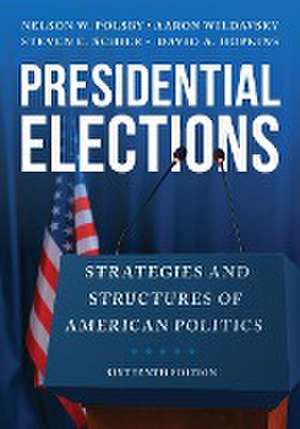Polsby, N: Presidential Elections
Autor David A. Hopkinsen Limba Engleză Paperback – 17 iul 2023
| Toate formatele și edițiile | Preț | Express |
|---|---|---|
| Paperback (1) | 462.75 lei 6-8 săpt. | |
| Rowman & Littlefield Publishers, Inc. – 17 iul 2023 | 462.75 lei 6-8 săpt. | |
| Hardback (1) | 641.43 lei 6-8 săpt. | |
| Rowman & Littlefield Publishers, Inc. – 25 iul 2023 | 641.43 lei 6-8 săpt. |
Preț: 462.75 lei
Nou
Puncte Express: 694
Preț estimativ în valută:
88.55€ • 93.37$ • 73.72£
88.55€ • 93.37$ • 73.72£
Carte tipărită la comandă
Livrare economică 10-24 ianuarie 25
Preluare comenzi: 021 569.72.76
Specificații
ISBN-13: 9781538183717
ISBN-10: 1538183714
Pagini: 328
Ilustrații: Text Boxes; Illustrations, unspecified; Graphs; Tables
Dimensiuni: 178 x 254 x 18 mm
Greutate: 0.57 kg
Ediția:Sixteenth Edition
Editura: Rowman & Littlefield Publishers, Inc.
ISBN-10: 1538183714
Pagini: 328
Ilustrații: Text Boxes; Illustrations, unspecified; Graphs; Tables
Dimensiuni: 178 x 254 x 18 mm
Greutate: 0.57 kg
Ediția:Sixteenth Edition
Editura: Rowman & Littlefield Publishers, Inc.
Cuprins
List of Figures, Tables, and Boxes
Preface
PART I. THE STRATEGIC ENVIRONMENT
1. VOTERS
Why People Don¿t Vote
Why People Do Vote: A Theory of Social Connectedness
Party Identification as Social Identity
Parties as Aggregates of Loyal Voters
Ideologies, Issues, and National Conditions in the Minds of Voters
Changes in Party Identification: Social Habit versus Contemporary Evaluation
A Central Strategic Problem: The Attentiveness of Voters
2. GROUPS
The Presidential Vote as an Aggregation of Interest Groups
Variations among Interest Groups
¿Special¿ Interests, Campaign Spending, and Public Interest Groups
Political Parties as Organizations
Third Parties
3. RULES AND RESOURCES
Rules: The Electoral College
Thinking About Resources
Resources: Money
Resources: Control over Information
Incumbency as a Resource: The Presidency
Incumbency as a Liability: The Vice Presidency
The Balance of Resources
PART II. SEQUENCES
4. THE NOMINATION PROCESS
Before the Voting Begins: The ¿Invisible Primary¿
The Early States
What Do These Historical Vignettes Teach?
Super Tuesday and Later Primaries
State and Territorial Caucuses
Delegate Allocation
Superdelegates
An Ever-Changing Nomination Process
The National Party Conventions
The Convention as Advertising
The Vice Presidential Nominee
The Future of National Conventions
5. THE CAMPAIGN
The Well-Traveled Candidates
Persuading Voters
Winning the Media Game
Campaign Professionals
Televised Debates
Getting Out the Vote
Campaign Blunders
Forecasting the Outcome
Counting the Vote
PART III. ISSUES
6. APPRAISALS
Reform upon Reform
The Political Theory of Policy Government
Reform by Means of Participatory Democracy
Some Specific Reforms
Party Platforms and Party Differences
7. AMERICAN PARTIES AND DEMOCRACY
Elections and Public Policy
Parties of Advocacy versus Parties of Intermediation
APPENDIXES
A. Vote by Groups in Presidential Elections, 1984¿2020
B. Voter Turnout in Presidential Elections, by Population Characteristics, 1984¿2020
C. Selections from the Democratic and Republican Party Platforms, 2020
Notes
Index
Preface
PART I. THE STRATEGIC ENVIRONMENT
1. VOTERS
Why People Don¿t Vote
Why People Do Vote: A Theory of Social Connectedness
Party Identification as Social Identity
Parties as Aggregates of Loyal Voters
Ideologies, Issues, and National Conditions in the Minds of Voters
Changes in Party Identification: Social Habit versus Contemporary Evaluation
A Central Strategic Problem: The Attentiveness of Voters
2. GROUPS
The Presidential Vote as an Aggregation of Interest Groups
Variations among Interest Groups
¿Special¿ Interests, Campaign Spending, and Public Interest Groups
Political Parties as Organizations
Third Parties
3. RULES AND RESOURCES
Rules: The Electoral College
Thinking About Resources
Resources: Money
Resources: Control over Information
Incumbency as a Resource: The Presidency
Incumbency as a Liability: The Vice Presidency
The Balance of Resources
PART II. SEQUENCES
4. THE NOMINATION PROCESS
Before the Voting Begins: The ¿Invisible Primary¿
The Early States
What Do These Historical Vignettes Teach?
Super Tuesday and Later Primaries
State and Territorial Caucuses
Delegate Allocation
Superdelegates
An Ever-Changing Nomination Process
The National Party Conventions
The Convention as Advertising
The Vice Presidential Nominee
The Future of National Conventions
5. THE CAMPAIGN
The Well-Traveled Candidates
Persuading Voters
Winning the Media Game
Campaign Professionals
Televised Debates
Getting Out the Vote
Campaign Blunders
Forecasting the Outcome
Counting the Vote
PART III. ISSUES
6. APPRAISALS
Reform upon Reform
The Political Theory of Policy Government
Reform by Means of Participatory Democracy
Some Specific Reforms
Party Platforms and Party Differences
7. AMERICAN PARTIES AND DEMOCRACY
Elections and Public Policy
Parties of Advocacy versus Parties of Intermediation
APPENDIXES
A. Vote by Groups in Presidential Elections, 1984¿2020
B. Voter Turnout in Presidential Elections, by Population Characteristics, 1984¿2020
C. Selections from the Democratic and Republican Party Platforms, 2020
Notes
Index
